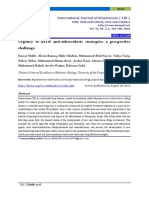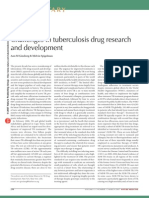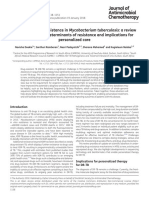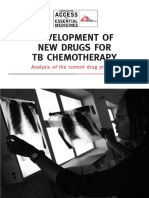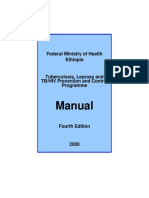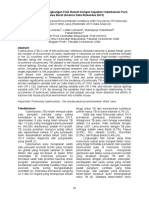Assistant Professor, Department of Pharmacology, KLEU's JN Medical College, Belgaum - Karnataka. India
Assistant Professor, Department of Pharmacology, KLEU's JN Medical College, Belgaum - Karnataka. India
Uploaded by
Mahesh T MadhavanCopyright:
Available Formats
Assistant Professor, Department of Pharmacology, KLEU's JN Medical College, Belgaum - Karnataka. India
Assistant Professor, Department of Pharmacology, KLEU's JN Medical College, Belgaum - Karnataka. India
Uploaded by
Mahesh T MadhavanOriginal Title
Copyright
Available Formats
Share this document
Did you find this document useful?
Is this content inappropriate?
Copyright:
Available Formats
Assistant Professor, Department of Pharmacology, KLEU's JN Medical College, Belgaum - Karnataka. India
Assistant Professor, Department of Pharmacology, KLEU's JN Medical College, Belgaum - Karnataka. India
Uploaded by
Mahesh T MadhavanCopyright:
Available Formats
International Journal of Drug Development & Research | April-June 2013 | Vol. 5 | Issue 2 | ISSN 0975-9344 | Available online http://www.ijddr.
in Covered in Official Product of Elsevier, The Netherlands SJR Impact Value 0.13 & H index 2 2013 IJDDR Bedaquiline: A Promising new agent for the treatment of MDR-TB
Jyoti M. Benni*
*
Assistant Professor, Department of Pharmacology, KLEUs JN Medical College, Belgaum.Karnataka. India.
Abstract Tuberculosis (TB) remains the single most infectious disease causing the highest mortality in humans. India is the highest TB burden country according to World Health Organization (WHO) statistics for 2011. The previous studies in India showed that 3% of multi drug resistant TB (MDR-TB) is seen in new tuberculosis cases and 17.2% among retreatment cases. The alarming increase in MDR-TB and the emergence of extensively drug resistant TB(XDR-TB) are man-made snags; therefore new drugs for the treatment of drug-resistant tuberculosis are obligatory.On 28thDecember 2012, the U.S. Food and Drug Administration approved bedaquiline (TMC207), as part of combination therapy to treat adults with MDR-TB when other alternatives are not available. Bedaquiline, a diarylquinoline has a unique mechanism of action and acts as a promising new agent in patients with MDR-TB.
Copyright 2013 IJDDR, Jyoti M. Benni. This is an open access paper distributed under the copyright agreement with Serials Publication, which permits unrestricted use, distribution, and reproduction in any medium, provided the original work is properly cited. Article History:-----------------------Date of Submission: 01-03-2013 Date of Acceptance: 08-03-2013 Conflict of Interest: NIL Source of Support: NONE INTRODUCTION Tuberculosis (TB) remains a major global health problem and stands a leading cause of death due to infectious disease, second only to human immunodeficiency virus and acquired immunodeficiency syndrome.1For several decades in the developing countries, eradication of tuberculosis remains to be a primary health challenge despite regular TB control programs adopted by governments. According to WHO-TB statistics for 2011, India has the highest TB burden country with an estimated incidence of 2.2 million cases out of a global incidence of 8.7 million cases and 1.4 million TB deaths.2,3 The TB prevalence in India for 2011 is estimated to be 3.1 million cases.3In India,TB bares the highest mortality rate in humans among the infectious diseases, about 3 million deaths annually, 5 deaths every minute.4Therefore, to curtail the existing problem in India, a notification was sent to
Review Paper
*Corresponding author, Mailing address: Dr. Jyoti M Benni C/o. Dr. B. R. Tubaki, Flat no 5, IInd floor, Ruturaj Apartments, Opposite Shiva Hotel, Near Kolhapur Circle, Belgaum. 590016. Karnataka, India. E Mail: benni_jyoti@yahoo.co.in
Key words: Bedaquiline, Tuberculosis, MDR-TB, XDR-TB. How to Cite this Paper: Jyoti M. Benni* Bedaquiline: A Promising new agent for the treatment of MDR-TB Int. J. Drug Dev. & Res., April-June 2013, 5(2): 24-28.
Int. J. Drug Dev. & Res., April-June 2013, 5 (2): 24-28 Covered in Scopus & Embase, Elsevier
24
Jyoti M. Benni : Bedaquiline: A Promising new agent for the treatment of MDR-TB
all states, declaring TB to be a notifiable disease, which means all health care professionals treating a TB patient had to report immediately every case of TB to the government.5 Short-course regimens of first-line drugs that can cure around 90% of cases have been available since the 1980s.3Inadequate TB treatment or harboring drug resistant tubercle bacilli can lead to the development of drug resistant TB. TB control is challenged by MDR-TB and XDR-TB. MDR-TB is defined as resistance to isoniazid (INH) and rifampicin (RMP) two of the most effective anti-TB drugs, with or without resistance to other drugs.6Globally in 2011, there were an estimated TB.7XDR-TB is defined as
28thDecember 2012, the U.S. Food and Drug Administration approved bedaquiline, as part of combination therapy to treat adults with multi-drug resistant tuberculosis (MDR-TB) when other alternatives are not available and also granted Sirturo fast track designation, priority review and orphanproduct designation.18 The drug demonstrated the potential to fill an unmet medical need, has the potential to provide safe and effective treatment where no satisfactory alternative therapy exists. 18 Chemical structure: 19, 20 IUPAC Name: (1R, 2S)-1-(6-bromo-2methoxyquinolin-3-yl)-4-(dimethylamino)-2naphthalen-1-yl-1-phenylbutan-2-ol. Molecular Formula: C32H31BrN2O2
630,000 cases of MDR-TB among the worlds 12 million prevalent cases of
Review Paper
resistance to INH and RMP plus any fluoroquinolone and at least one of the injectable agents: kanamycin [KM], amikacin [AMK] or capreomycin [CPM]).8,
9Totally
drug resistant TB(XXDR-TB or TDR-TB) is
defined as resistant to a wider range of drugs has also now been detected. TDR-TB is resistant to all the first and second line TB drugs and it is extremely difficult to treat.10, 11 Novel TB drugs are obligatoryto tackle the major problem of prevention and treatment of drug resistance. The expansion of newer agents is an urgent priority for the restraint of MDR-TB and XDR-TB and also need for better and rapid diagnostic assays for early detection of TB.12, 13Several new molecules and early detection techniques are being researched in the management of TB; BEDAQUILINE is the first new FDA approved drug in 40 years to fight against MDR-TB.14, 15 Drug review: Adiarylquinoline anti-tuberculosis drug, Bedaquiline (also known as Sirturo, TMC207 or R207910)was discovered by a team led by the BelgianKoenAndries at Janssen Pharmaceutica.16It is manufactured by Johnson & Johnson (J&J), who sought accelerated approval of the drug for treatment of multi-drug-resistant tuberculosis.17On Mechanism of action: TMC207 a diarylquinoline compound that offers a new mechanism of antituberculosis action by specifically targeting mycobacterial proton pump of adenosine triphosphate (ATP) synthase, leading to inadequate synthesis of ATP (reduced generation of energy in Mycobacterium tuberculosis).21,
22Its
MIC
for M. tuberculosis is 0.06 g/ml and it has no cross resistance with existing anti-tuberculosis antibiotics.
21Bedaquiline
is active against most isolates of
Mycobacterium tuberculosis. In vitro, TMC207 potently inhibits drug-sensitive and drug-resistant M. tuberculosis isolates against dormant bacilli.24TMC207 has
21, 23and
is also bactericidal tubercle concentration-
(non-replicating) shown
25
dependent anti-bacterial activity. Pharmacokinetics:26
25
Int. J. Drug Dev. & Res., April-June 2013, 5 (2): 24-28 Covered in Scopus & Embase, Elsevier
Jyoti M. Benni: Bedaquiline: A Promising new agent for the treatment of MDR-TB
Bedaquiline is well absorbed orally and post dose maximum plasma concentration (Cmax) is 5 hours. Food increases its bioavailability. The plasma protein binding of bedaquiline is > 99.9%. The volume of distribution in the central compartment is estimated to be approximately 164 L. Cytochrome P4503A4 metabolizes TMC207 into its major Nmonodesmethyl metabolite, which is about five times less active than the parent compound. Both compounds are eliminated with long terminal halflives of 5060 hrs in mice, suggesting extensive tissue binding.25Based on preclinical studies, bedaquiline is eliminated mainly in feces. The urinary excretion of unchanged bedaquiline was < 0.001% of the dose in clinical studies, indicating that renal clearance of unchanged drug is insignificant. Efficacy studies: Preclinical potential studies: Bedaquiline activity exhibited and also and of antimycobacterial of in isoniazid, the positive
In the first trial29, newly diagnosed, smear MDR-TB (pulmonary) patients were randomly assigned to be treated with bedaquiline or placebo in combination with a standard five-drug regimen, second-line anti-tuberculosis regimen for 8 weeks. This study revealed, the addition of TMC207 (48%) to the standard drug regimen for MDR-TB resulted in quicker conversion to a negative sputum culture compared to placebo group (9%).The median rates of smear negative for acid-fast bacilli at week 4 were 77% and 57% for the TMC207 and placebo group and at week 8 were 84% and 68% for the TMC207 and placebo group respectively. Also TMC207had an acceptable side-effect profile. 29 In the second trial30, all patients received either bedaquiline or placebo for 24 weeks in addition to other anti-TB drugs. The median time of sputum culture conversion were 78 days for TMC207, compared with 129 days in patients treated with placebo.Those who received TMC207 were at lower risk of acquisition of additional drug resistance over the whole duration of follow-up. The side effects incidence was similar in the patients who received bedaquiline (82.6%) compared to those who had received placebo (79.2%). The majority of the adverse events recorded here were of mild or moderate intensity. A phase 3 trial of bedaquiline, TMC207C210, is due to start in March 2013. It will be a double blind study of 600 patients with sputum smear positive MDR-TB, which will compare TB treatment with bedaquiline and a background regimen, with placebo and a background regimen.31 Safety and tolerability:26 The most common adverse reactions reported were nausea, arthralgia, and headache. Other adverse events reported were hemoptysis and chest pain in 10% of patients treated with bedaquiline, with a higher frequency than the placebo treatment group.26,29 No clinically relevant heart rate changes or electrocardiographic QRS or PR interval were observed during the study. In both the treatment groups, mean increase in the corrected QT
Review Paper
accelerated clearance of bacilli, as similar tothe combination pyrazinamide rifampin, model murine showed
27
tuberculosis.21TMC207
synergistic
interaction with pyrazinamide.
Similarly, TMC207
enhances the antibacterial activity of second-line drug combinations in the murine model of drugsensitive tuberculosis.28 Clinical studies: The demonstration of antimycobacterial potential of bedaquiline in preclinical modelspaved way for further efficacy studies in humans.The drug has been approved on the basis of the results of two phase II trials. The study was randomized, double-blind, placebo-controlled study to evaluate the safety, tolerability and efficacy of bedaquiline when it is added to a background regimen (BR) in newly diagnosed patients with MDR pulmonary TB was conducted in two stages. Both studies were designed to measure the time to conversion to a negative sputum culture.
Int. J. Drug Dev. & Res., April-June 2013, 5 (2): 24-28 Covered in Scopus & Embase, Elsevier
26
Jyoti M. Benni: Bedaquiline: A Promising new agent for the treatment of MDR-TB
interval was observed but was more pronounced in the TMC207 group (p> 0.05). No dosage adjustment is required in patients with mild to moderate renal or hepatic impairment. Caution in patients with severe renal or hepatic impairment. Alcohol and other hepatotoxic drugs should be avoided. Dosage and precautions: The recommended dose of bedaquiline for the treatment of pulmonary MDR-TB in adults is 400mg oncedaily for 2 weeks, followed by 200mg 3 times per week for 22 weeks, with a total duration of 24 weeks, taken with food and in combination with other anti-TB drugs. 26, 32The drug bares a black-box warning for arrhythmias, therefore advised frequent ECG monitoring during the treatment.
18
established, hence upcoming exploration is necessary in this area. REFERENCES
1) Corbett EL, Watt CJ, Walker N, et al. The growing burden of tuberculosis: global trends and interactions with the HIV epidemic. Arch Intern Med 2003; 163: 1009-21. 2) TB India 2012. Revised National TB Control Programme. Annual status report 2012. Govt. of India. Tuberculosis epidemiology-India. Page 7. 3) "Global Tuberculosis Control 2012, WHO, Geneva, 2012 http://www.who.int/tb/publications/global_report/en 4) DakshinaBisht. Can Newer Diagnostic Microbiological Assays Guide Early Tuberculosis Management? Indian J Tuberc 2011; 58:51-53. 5) Sinha K. "Finally, tuberculosis declared a notifiable disease", The Times of India, May 9, 2012. http://articles.timesofindia.indiatimes.com/2012-0509/india/31640562_1_mdr-tb-tb-cases-tb-diagnosis. 6) Rajendra Prasad. Multidrug And Extensively DrugResistant Tb (M / Xdr-Tb): Problems and Solutions. Indian J Tuberc 2010; 57: 180-191. 7) Global Tuberculosis Report 2012. Chapter 2, The Burden of disease caused by TB, WHO, Geneva. Page 20. 8) 9) Holtz TH, Cegielski JP. Origin of the term XDR-TB. Eur. Respir. J. 2007; 30: 396. Migliori GB, Loddenkemper R, Blasi F et al. 125 years afterRobert Kochs discovery of the tubercle bacillus: the newXDR-TB threat. Is science enough to tackle the epidemic? Eur. Respir. J. 2007; 29: 4237. 10) Katherine Rowland (13 January 2012). "Totally drugresistant TB emerges in India". Nature. http://www.nature.com/news/totally-drug-resistanttb-emerges-in-india-1.9797 11) Velayati AA, Masjedi MR, Farnia P, et al. Emergence of new forms of totally drug resistant tuberculosis bacilli: super extensively drug-resistant tuberculosis or totally drug resistant strains in Iran. Chest 2009; 136:4205. 12) Nachega j b, chaisson r e. Tuberculosis (suppl 1): s24s30. 13) Chen-yuan Chiang, Rosella Centis and Giovanni Battista Migliori. Drug-resistant tuberculosis: past, present, future. Respirology(2010) 15, 413432. drug resistance: a global threat. Clin infect dis 2003; 36
Withdraw
bedaquiline, when total bilirubin elevation > 2xULN or aminotransferase elevations are > 8xULN or aminotransferase elevations persist beyond 2 weeks.
26
Review Paper
CONCLUSION Adherence to appropriate standards of care and control is imperative and a top priority in order to prevent drug resistance in TB. The occurrence of MDR-TB and XDR-TB is related to poor TB control, due to improper use of second-line anti-TB drugs. The current need of an hour is the rational use of new drugs/regimens for the treatment of TB.Bedaquiline, a new FDA approved drug must be used in combination with other 2nd line anti-tubercular drugs to treat MDR-TB in adults, when other alternatives are not available and it is administered by DOTS. Future prospects include, clinical trials with good study design and large sample size are vital to rationalize the treatment, plus to reduce mortality, morbidity and economic losses, thereby improving TB scenario all over the world. The safety and efficacy of bedaquiline for the treatment of latent TB, drug sensitive TB and extra pulmonary TB has not been
27
Int. J. Drug Dev. & Res., April-June 2013, 5 (2): 24-28 Covered in Scopus & Embase, Elsevier
Jyoti M. Benni: Bedaquiline: A Promising new agent for the treatment of MDR-TB
14)
"FDA Approves 1st New Tuberculosis Drug in 40 Years". Yahoo news. Retrieved 31 December 2012. http://news.yahoo.com/fda-approves-1st-tuberculosisdrug-40-years-152508824--finance.html.
28)
Lounis N, Veziris14. N, Chauffour A, Truffot-Pernot C, Andries K, Jarlier V. Combinations of R207910 with drugs used to treat multidrug-resistant tuberculosis have the potential to shorten treatment duration. Antimicrob Agents Chemother 2006;50:3543-7.
15)
Matthew Perrone."F.D.A. Approves New Tuberculosis Drug". New York Times. Retrieved 31 December 2012. www.boston.com/.../fda-approves-new-tuberculosisdrug.../story.html. 29)
Diacon AH, Pym A, Grobusch M, Patientia R, Rustomjee R, Page-Shipp L, Pistorius C, Krause R, Bogoshi M, Churchyard G, Venter A, Allen J, Palomino JC, De Marez T, van Heeswijk RP, Lounis N, Meyvisch P, Verbeeck J, Parys W, de Beule K, Andries K, McNeeley DF. The diarylquinoline TMC207 for multidrug-resistant tuberculosis. N Engl J Med. 2009 Jun 4;360(23):2397-405.
16)
deJonge MR, Koymans LH, Guillemont JE, Koul A, Andries K (June 2007). "A computational model of the inhibition of Mycobacterium tuberculosis ATPase by a new drug candidate R207910". Proteins67 (4): 97180.
17)
"J&J&J Sirturo Tuberculosis Drug Gets Fast-Track Clearance". Wall Street Journal. Retrieved 2013-0101.) 30)
Diacon AH, Donald PR, Pym A, Grobusch M, Patientia RF, Mahanyele R, Bantubani N, Narasimooloo R, De Marez T, van Heeswijk R, Lounis N, Meyvisch P, Andries K, McNeeley DF. Randomized pilot trial of eight weeks of bedaquiline (TMC207) treatment for multidrug-resistant tuberculosis: long-term outcome, tolerability, and effect on emergence of drug resistance. Antimicrob Agents Chemother. 2012 Jun;56(6):3271-6.
18) 19)
http://www.fda.gov/NewsEvents/Newsroom/PressAn nouncements/ucm333695.htm Bedaquiline - Compound Summary. http://pubchem.ncbi.nlm.nih.gov/summary/summary .cgi?cid=5388906.
Review Paper
20) 21)
en.wikipedia.org/wiki/Bedaquiline Andries K, Verhasselt P, Guillemont J, et al. A diarylquinoline drug active on the ATP synthase of Mycobacterium tuberculosis. Science 2005; 307:223-7. 31)
A Study to Evaluate the Efficacy and Safety of TMC207 in Patients with Pulmonary Infection with Multi-drug Resistant Mycobacterium Tuberculosis. http://clinicaltrials.gov/ct2/show/NCT01600963acces sed on February 11, 2013.
22)
Koul
A,
Dendouga
N,
Vergauwen
K,
et
al. 32)
Diarylquinolines target subunit c of mycobacterial ATP synthase. Nat ChemBiol 2007;3:323-4. 23) Huitric E, Verhasselt P, Andries K, Hoffner SE. In vitro antimycobacterial spectrum of a diarylquinoline ATP synthase inhibitor. Antimicrob Agents Chemother 2007;51:4202-4. 24) Koul A, Vranckx L, Dendouga N, et al. Diarylquinolines are bactericidal for dormant mycobacteria as a result of disturbed ATP homeostasis. J BiolChem 2008;283: 25273-80. 25) Rouan MC, Lounis N, Gevers T, et al. Pharmacokinetics and pharmacodynamics of TMC207 and its N-desmethyl metabolite in a murine model of tuberculosis. Antimicrob Agents Chemother 2012; 56: 14441451.
http://www.fda.gov/downloads/AdvisoryCommittees/ CommitteesMeetingMaterials/Drugs/AntiInfectiveDrugsAdvisoryCommittee/UCM329260.pdf
26)
Highlights of prescribing information [Internet]. Initial U.S. Approval-2012. Reference ID: 3237647 available from: www.accessdata.fda.gov/drugsatfda_docs/label/.../20 4384s000lbl.pdf.(accessed on 9th feb2013).
27)
Ibrahim M, Andries K, Lounis N, et al. with pyrazinamide against murine tuberculosis Antimicrob Agents Chemother2007;51:1011-5.
Int. J. Drug Dev. & Res., April-June 2013, 5 (2): 24-28 Covered in Scopus & Embase, Elsevier
28
You might also like
- Tuberculosis in Infancy and Childhood 4th Ed (PPS)Document268 pagesTuberculosis in Infancy and Childhood 4th Ed (PPS)Jessica Mariano100% (1)
- Anti-Infectives Drug Advisory Committee MeetingDocument253 pagesAnti-Infectives Drug Advisory Committee MeetingbellamajNo ratings yet
- Evaluating Bedaquiline As A Treatment Option For Multidrug-Resistant TuberculosisDocument8 pagesEvaluating Bedaquiline As A Treatment Option For Multidrug-Resistant Tuberculosisa29921No ratings yet
- No 2Document6 pagesNo 2Raven RavenNo ratings yet
- Nihms 1810616Document20 pagesNihms 1810616FireNo ratings yet
- Burden of Tuberculosis - Combating Drug Resistance: EditorialDocument3 pagesBurden of Tuberculosis - Combating Drug Resistance: EditorialmominamalikNo ratings yet
- Tuberculosis:Development of New Drugs and Treatment RegimensDocument10 pagesTuberculosis:Development of New Drugs and Treatment RegimensMedylin DualloNo ratings yet
- Be Daqui LinaDocument10 pagesBe Daqui LinaMario Jimenez JimenezNo ratings yet
- Advances in Tuberculosis: Therapeutics: (August 2019) 86 (8) :700 - 702Document3 pagesAdvances in Tuberculosis: Therapeutics: (August 2019) 86 (8) :700 - 702Harpreet SinghNo ratings yet
- Paper TB MDRDocument8 pagesPaper TB MDREra SulistiyaNo ratings yet
- New JaneDocument34 pagesNew JaneniputusellyowNo ratings yet
- TUBERCULOSISDocument4 pagesTUBERCULOSISLâm NguyễnNo ratings yet
- Linezolid To Treat MDR-/XDR-tuberculosis: Available Evidence and Future ScenariosDocument5 pagesLinezolid To Treat MDR-/XDR-tuberculosis: Available Evidence and Future ScenariosNop PiromNo ratings yet
- Journal Reading #14 - TuberculosisDocument4 pagesJournal Reading #14 - TuberculosisEure AlejandrinoNo ratings yet
- Sweeney Et Al. 2022Document12 pagesSweeney Et Al. 2022Mohamad Baihaqi Mohamad BasriNo ratings yet
- What Is New in Management of Pediatric TuberculosisDocument9 pagesWhat Is New in Management of Pediatric Tuberculosisviani ayalNo ratings yet
- Multidrug-Resistant Tuberculosis (MDR-TB) Is Defined As TB That Is Resistant To BothDocument4 pagesMultidrug-Resistant Tuberculosis (MDR-TB) Is Defined As TB That Is Resistant To Bothsanny_sundariNo ratings yet
- Recent Advances in The Development of Anti-Tuberculosis Drugs Acting On Multidrug-Resistant Strains: A ReviewDocument18 pagesRecent Advances in The Development of Anti-Tuberculosis Drugs Acting On Multidrug-Resistant Strains: A Reviewmalik003No ratings yet
- Minireview: New Drugs Against Tuberculosis: Problems, Progress, and Evaluation of Agents in Clinical DevelopmentDocument14 pagesMinireview: New Drugs Against Tuberculosis: Problems, Progress, and Evaluation of Agents in Clinical DevelopmentcgandarelaNo ratings yet
- Zhang 2015Document15 pagesZhang 2015Annisa Nurfiatul AiniNo ratings yet
- Urgency of Novel Anti-Tuberculosis Strategies: A Prospective ChallengeDocument16 pagesUrgency of Novel Anti-Tuberculosis Strategies: A Prospective ChallengeArshia NazirNo ratings yet
- JurnalDocument4 pagesJurnalAnonymous pfHZusnNo ratings yet
- Introduction 1Document21 pagesIntroduction 1Amsmrit BorahNo ratings yet
- TRT2017 4920209Document12 pagesTRT2017 4920209ADVOCATE ASHUTOSH SHARMANo ratings yet
- International Journal of Infectious DiseasesDocument4 pagesInternational Journal of Infectious DiseasesPedro MalikNo ratings yet
- New Drugs For Tuberculosis PDFDocument14 pagesNew Drugs For Tuberculosis PDFRichard WooliteNo ratings yet
- Jurnal Korea Pemilihan Regimen Long Dari Pada Regimen ShortDocument9 pagesJurnal Korea Pemilihan Regimen Long Dari Pada Regimen Shorthasan andrianNo ratings yet
- Multi Drug ResistenDocument2 pagesMulti Drug ResistenNurul W.ANo ratings yet
- TB 2Document11 pagesTB 2giant nitaNo ratings yet
- Ginsberg and Spigelman Nat Med 2007Document5 pagesGinsberg and Spigelman Nat Med 2007hst939No ratings yet
- Thesis PDFDocument46 pagesThesis PDFShariqNo ratings yet
- Treatment Outcomes Among Pediatric Patients With Highly Drug-Resistant Tuberculosis, The Role of New and Repurposed Second-Line Tuberculosis DrugsDocument11 pagesTreatment Outcomes Among Pediatric Patients With Highly Drug-Resistant Tuberculosis, The Role of New and Repurposed Second-Line Tuberculosis DrugsKang LimbaNo ratings yet
- PSM 2 PypDocument186 pagesPSM 2 PypsuriNo ratings yet
- What Is Multidrug-Resistant Tuberculosis (MDR-TB) and How Do We Control It?Document2 pagesWhat Is Multidrug-Resistant Tuberculosis (MDR-TB) and How Do We Control It?Dvica SarahNo ratings yet
- Singh., 2020. Mekanisme Resistensi ObatDocument21 pagesSingh., 2020. Mekanisme Resistensi Obathasan andrianNo ratings yet
- Journal of TBCDocument14 pagesJournal of TBCaura tmc 10No ratings yet
- Accepted Manuscript: 10.1016/j.jinf.2017.08.005Document28 pagesAccepted Manuscript: 10.1016/j.jinf.2017.08.005Adrian Quiroga RodriguezNo ratings yet
- Journal of Internal Medicine - 2014 - Parida - Totally Drug Resistant Tuberculosis and Adjunct TherapiesDocument18 pagesJournal of Internal Medicine - 2014 - Parida - Totally Drug Resistant Tuberculosis and Adjunct TherapiesAna ArandaNo ratings yet
- Multi Drug Resistance in ChildrenDocument11 pagesMulti Drug Resistance in ChildrenMuneeb AltafNo ratings yet
- BMJ m216 FullDocument18 pagesBMJ m216 Fulldiaspalma.medNo ratings yet
- Drug Resistance of TBDocument17 pagesDrug Resistance of TBGaurav Sharma100% (1)
- Peloquin 2021Document38 pagesPeloquin 2021RhysandNo ratings yet
- Paper Alumnos 3 PDFDocument10 pagesPaper Alumnos 3 PDFVictor Martinez HagenNo ratings yet
- Short-Course Treatment For Multidrug-Resistant Tuberculosis: The STREAM TrialsDocument7 pagesShort-Course Treatment For Multidrug-Resistant Tuberculosis: The STREAM TrialsSariNo ratings yet
- WHO Bulletin 2005Document10 pagesWHO Bulletin 2005ajh2675No ratings yet
- DKX 506Document14 pagesDKX 506د. محمد سند راشد الحصينيNo ratings yet
- 2012 JIFD New Drugs for Treatment of TB Needs, Challenges...Document9 pages2012 JIFD New Drugs for Treatment of TB Needs, Challenges...humourclubistakenNo ratings yet
- Development of New Drugs For TB Chemotherapy: Analysis of The Current Drug PipelineDocument48 pagesDevelopment of New Drugs For TB Chemotherapy: Analysis of The Current Drug Pipelinereadyboy89No ratings yet
- BY Dr. Tahmina AzharDocument71 pagesBY Dr. Tahmina Azharscribdnotes123No ratings yet
- Clinical Implications of New Drugs and Regimens For The Treatment of Drug-Resistant TuberculosisDocument7 pagesClinical Implications of New Drugs and Regimens For The Treatment of Drug-Resistant TuberculosisLiêm NguyễnNo ratings yet
- Treatment of Highly Drug-Resistant Pulmonary TuberculosisDocument10 pagesTreatment of Highly Drug-Resistant Pulmonary TuberculosisErnest ChottaNo ratings yet
- Global Health Case Study CMHDocument6 pagesGlobal Health Case Study CMHapi-482580060No ratings yet
- Health Interventions To Improve The Medication Efficacy in Tuberculosis TreatmentDocument27 pagesHealth Interventions To Improve The Medication Efficacy in Tuberculosis Treatmentkj185No ratings yet
- Use Only: Oral Anti-Tuberculosis Drugs: An Urgent Medication Reconciliation at Hospitals in IndonesiaDocument7 pagesUse Only: Oral Anti-Tuberculosis Drugs: An Urgent Medication Reconciliation at Hospitals in IndonesiaHeryanti PusparisaNo ratings yet
- SodapdfDocument77 pagesSodapdfShariqNo ratings yet
- A Review On Tuberculosis Combinational Treatment and Drug Regimens.Document22 pagesA Review On Tuberculosis Combinational Treatment and Drug Regimens.Sujit KakadeNo ratings yet
- Pharmacological Research: ReviewDocument12 pagesPharmacological Research: ReviewHeryanti PusparisaNo ratings yet
- Clinical Case of Multidrug-Resistant in King Khalid Hospital, HailDocument2 pagesClinical Case of Multidrug-Resistant in King Khalid Hospital, HailryoNo ratings yet
- Multidrug Resistant Tuberculosis A Pharmacological View Based On Revised National Tuberculosis Control Programme DOTS-Plus GuidelinesDocument7 pagesMultidrug Resistant Tuberculosis A Pharmacological View Based On Revised National Tuberculosis Control Programme DOTS-Plus GuidelinesIOSR Journal of PharmacyNo ratings yet
- Impact of Bedaquiline Regimen On The Treatment Success Rates of Multidrug Resistant Tuberculosis Patients in EgyptDocument9 pagesImpact of Bedaquiline Regimen On The Treatment Success Rates of Multidrug Resistant Tuberculosis Patients in Egyptaura tmc 10No ratings yet
- COVID-19 Mortality Review in Malaysia & Updates on Clinical Management of COVID-19From EverandCOVID-19 Mortality Review in Malaysia & Updates on Clinical Management of COVID-19No ratings yet
- Acute Leukemia Best ArticleDocument8 pagesAcute Leukemia Best ArticleMahesh T MadhavanNo ratings yet
- How To Improve Reading Comprehension Skills - 2Document1 pageHow To Improve Reading Comprehension Skills - 2Mahesh T MadhavanNo ratings yet
- Ancient History: Unit 5 - Ancient IndiaDocument2 pagesAncient History: Unit 5 - Ancient IndiaMahesh T MadhavanNo ratings yet
- 101 Interesting Facts About India - India Unimagined! PDFDocument5 pages101 Interesting Facts About India - India Unimagined! PDFMahesh T MadhavanNo ratings yet
- American Political Science AssociationDocument2 pagesAmerican Political Science AssociationMahesh T MadhavanNo ratings yet
- Advt - No. 4A /2012-13: I (First) II (Second) II (Second) 60% 55% 50% 6.75 6.25 5.75Document4 pagesAdvt - No. 4A /2012-13: I (First) II (Second) II (Second) 60% 55% 50% 6.75 6.25 5.75Mahesh T MadhavanNo ratings yet
- Cell Membranes: The Fluid-Mosaic ModelDocument31 pagesCell Membranes: The Fluid-Mosaic ModelMahesh T MadhavanNo ratings yet
- Respiration: Gas ExchangeDocument24 pagesRespiration: Gas ExchangeMahesh T MadhavanNo ratings yet
- TMC 207 (Bedaquiline) : A New Weapon Against MDR and XDR-TB: Presented by Mohit Kumar Dwivedi Ms - Pharm 1 SEM BiotechnologyDocument19 pagesTMC 207 (Bedaquiline) : A New Weapon Against MDR and XDR-TB: Presented by Mohit Kumar Dwivedi Ms - Pharm 1 SEM BiotechnologyMahesh T MadhavanNo ratings yet
- TB Dots Ri Dan RJ Jan - Juli 2020Document6 pagesTB Dots Ri Dan RJ Jan - Juli 2020Dina MariyanaNo ratings yet
- National TB Control ManualDocument223 pagesNational TB Control ManualTrishenth FonsekaNo ratings yet
- Multidrug-Resistant Tuberculosis: Agus Suharto BasukiDocument45 pagesMultidrug-Resistant Tuberculosis: Agus Suharto BasukidrhendraagusNo ratings yet
- Pedoman Nasional Pengendalian TuberkulosisDocument111 pagesPedoman Nasional Pengendalian TuberkulosisYusriNo ratings yet
- ID Hubungan Lama Penggunaan Obat Anti TuberDocument10 pagesID Hubungan Lama Penggunaan Obat Anti TuberIvan HeriawanNo ratings yet
- WHO MDR 2020 Handbook Treatment PDFDocument88 pagesWHO MDR 2020 Handbook Treatment PDFYuanita GunawanNo ratings yet
- Penugasan Mata Kuliah Metodologi Penelitian TOPIK: Masalah Keperawatan & Literature ReviewDocument11 pagesPenugasan Mata Kuliah Metodologi Penelitian TOPIK: Masalah Keperawatan & Literature ReviewSindi SugandiNo ratings yet
- Testing For Tuberculosis (TB) : Tuberculin Skin Test (TST)Document2 pagesTesting For Tuberculosis (TB) : Tuberculin Skin Test (TST)Aluh L DiniNo ratings yet
- PTB Guidelines 2006 IntroductionDocument17 pagesPTB Guidelines 2006 IntroductionMaria Concepcion Connie DingleNo ratings yet
- Surgical Management of LeprosyDocument29 pagesSurgical Management of LeprosyVijay KumarNo ratings yet
- Ethiopian TB 2008 PDFDocument207 pagesEthiopian TB 2008 PDFabel semuNo ratings yet
- Manual: Federal Ministry of Health EthiopiaDocument196 pagesManual: Federal Ministry of Health Ethiopiaalfonso delgadoNo ratings yet
- Idsa Tratamiento TBC EspañolDocument8 pagesIdsa Tratamiento TBC EspañolJosé D. Lira BouttóNo ratings yet
- Tuberculosis ArticleDocument7 pagesTuberculosis ArticleMaria BacasnoNo ratings yet
- TB in PregnancyDocument36 pagesTB in PregnancyKarthick NavinNo ratings yet
- Analisis Upaya Penemuan Kasus Tuberkulosis Anak Di Kabupaten Lima Puluh Kota Tahun 2019Document10 pagesAnalisis Upaya Penemuan Kasus Tuberkulosis Anak Di Kabupaten Lima Puluh Kota Tahun 2019Desy ApriantiNo ratings yet
- Hubungan Kondisi Lingkungan Fisik Rumah Dengan Kejadian Tuberkulosis Paru Di Jawa Barat (Analisis Data Riskesdas 2013)Document6 pagesHubungan Kondisi Lingkungan Fisik Rumah Dengan Kejadian Tuberkulosis Paru Di Jawa Barat (Analisis Data Riskesdas 2013)Nova RizkenNo ratings yet
- Page-4 Ni 23 MarchDocument1 pagePage-4 Ni 23 MarchThingsulthliahNo ratings yet
- MycobacteriumDocument6 pagesMycobacteriumRami AlhilliNo ratings yet
- Dr. Wahyuni Indawati, Spa (K)Document43 pagesDr. Wahyuni Indawati, Spa (K)Rara AnisaNo ratings yet
- Jurnal Skripsi Sabam GultomDocument3 pagesJurnal Skripsi Sabam GultomDavid Galatia TambaNo ratings yet
- Tuberculosis For Dec 1Document23 pagesTuberculosis For Dec 1Tony Rose Reataza-BaylonNo ratings yet
- Jurnal TB Nasiaonal 1Document11 pagesJurnal TB Nasiaonal 1Natalia SomboalloNo ratings yet
- 160 Nur Darmawan FormatingDocument15 pages160 Nur Darmawan FormatingYuli LestariNo ratings yet
- CIAVDocument5 pagesCIAVAdolfo KwanNo ratings yet
- Gambaran Penemuan Kasus Tuberkulosis Paru Oleh Petugas Puskesmas Di Kabupaten SukoharjoDocument8 pagesGambaran Penemuan Kasus Tuberkulosis Paru Oleh Petugas Puskesmas Di Kabupaten SukoharjoBenti Eka WatiNo ratings yet
- 10.1007@s10096 019 03768 9Document6 pages10.1007@s10096 019 03768 9Dany Daniel Rafael HuamanNo ratings yet
- Global Tuberculosis Report 2014Document171 pagesGlobal Tuberculosis Report 2014Promosi Sehat100% (1)
- Mycobacterium LepraeDocument25 pagesMycobacterium LepraeWilly FernandoNo ratings yet




















